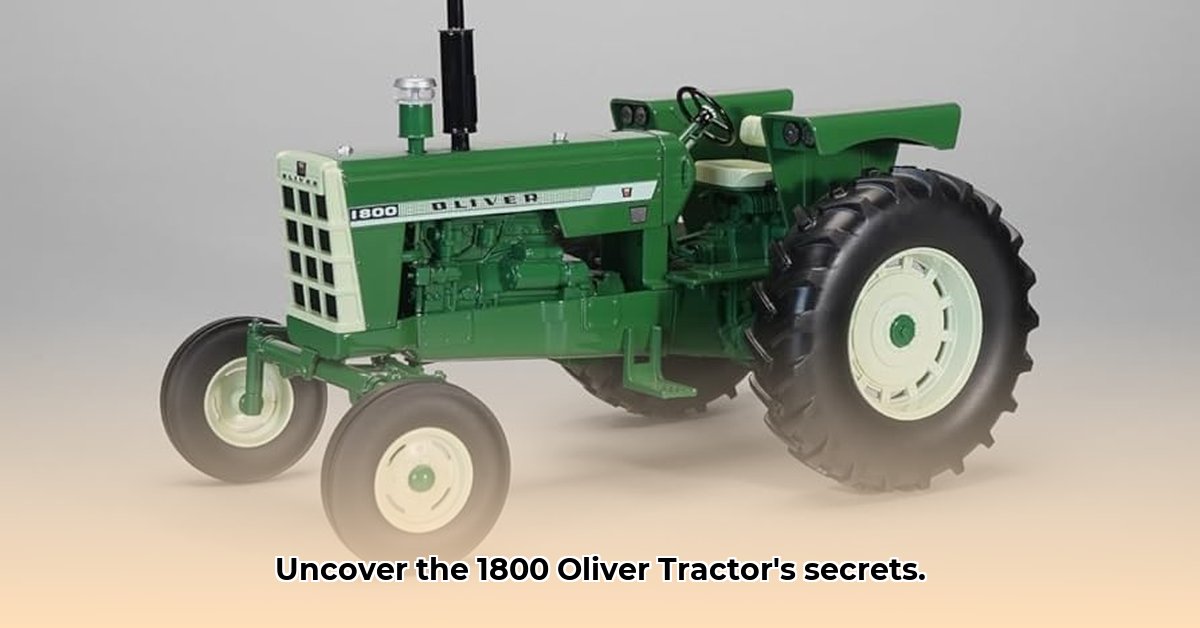
The Oliver 1800 tractor, a stalwart of the 1960s farming landscape, wasn't just another machine; it was a symbol of both robust engineering and the evolving understanding of sustainable agriculture. This article delves into the history of this iconic tractor, exploring its design, its impact on farming practices, and its surprisingly relevant legacy in today's world of environmentally conscious agriculture. We'll examine its evolution, its technical specifications, and its place within the broader context of sustainable farming practices—past and present. For more Oliver Tractor merchandise, check out this site.
The Oliver 1800: A Three-Act Play of Agricultural Innovation
The Oliver 1800 wasn't a single model; it was a trilogy of tractors—the A, B, and C models—each representing a step forward in refinement and efficiency. Think of them as three acts in a play, each building upon the strengths of its predecessor. These weren't revolutionary changes, but rather a series of carefully considered improvements, echoing the sustainable farming philosophy of the era: maximizing existing resources and working smarter, not harder. Each model, with its subtle enhancements, reveals a commitment to optimizing performance and longevity.
Under the Hood: The Mechanics of a Durable Workhorse
The Oliver 1800 was built for hard work, not show. Its robust design—a testament to Oliver's engineering prowess—emphasized durability. The integration of Waukesha-Oliver engines, a key element of the tractor's design, illustrates a commitment to quality control and ensured optimal performance. This vertical integration further aligns with the broader concept of sustainable supply chains and reduced environmental footprint.
The engine's displacement gradually increased with each new model, resulting in enhanced capabilities to handle heavier loads. The transmission also saw significant upgrades; the Model C featured a 12-speed partial power shift, a substantial improvement that significantly enhanced operational efficiency and operator control. Imagine the difference this made during long hours of plowing in tough conditions!
| Series | Engine Displacement (cu in) | Transmission | Approximate Power (HP) | Key Features |
|---|---|---|---|---|
| A | Further research needed | 6-speed | Further research needed | Standard features for the time |
| B | Further research needed | 6-speed | Further research needed | Minor improvements over Model A |
| C | Further research needed | 12-speed partial power shift | Further research needed | Tilt steering for improved operator comfort |
Note: Precise engine displacement and horsepower figures require further research.
Sustainability: Then and Now – A Shifting Perspective
The concept of "sustainable agriculture" has undergone a dramatic shift since the 1960s. While the 1800 Oliver's durability—minimizing repairs and replacements—was a sustainability victory of its time, modern metrics demand a much broader assessment. Today, fuel efficiency, reduced emissions, and minimized environmental impact are also key considerations (and those, in fact, are not reflected in the older tractor). How, then, does the Oliver 1800 stack up against contemporary standards?
Wasn't the Oliver 1800 perfectly "sustainable" by today's standards? Probably not, in comparison to modern machines. However, its long lifespan and robust construction significantly minimized resource consumption over its lifetime. It's this longevity that adds to the discussion on sustainability.
A Lasting Legacy: More Than Just a Machine
The Oliver 1800, while not a technological revolution, holds a significant place in agricultural history. It symbolizes the incremental advancements that have defined progress in farming. For collectors and historians, it represents a golden era of farming machinery. It is a remarkable piece of engineering and provides insights into how the concept of sustainability has evolved. The tractor's story sparks reflection on what "sustainable" truly encompasses, prompting a continuous reassessment and refinement of agricultural practices. Further research into the Oliver 1800 and similar machines could reveal further insights into the evolution of sustainable farming practices.
How to Compare Oliver 1800 Tractor Fuel Efficiency to Modern Sustainable Alternatives
Key Takeaways:
- The Oliver 1800 displayed surprisingly efficient fuel consumption for a gasoline tractor of its era, according to Nebraska Tractor Test data.
- Direct comparisons to modern sustainable alternatives are complex due to differences in testing methodologies, tractor configurations, and engine load.
- Modern diesel tractors, with their advanced engine technology, significantly outperform the Oliver 1800 in fuel efficiency.
- Understanding the historical context is crucial when evaluating the Oliver 1800's performance. It's unfair to compare it directly to a modern tractor.
- Factors like auxiliary equipment and operating conditions greatly influence fuel consumption, complicating simple comparisons.
- Thorough research and careful consideration are necessary for a fair and accurate assessment of fuel efficiency across different eras and technologies.